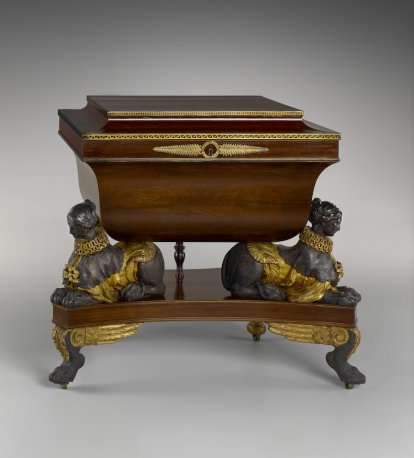Cellarette with Sphinxes and Winged Sun Disk
Overview
Cellarette with Sphinxes and Winged Sun Disk [ edit ]
Designed to fit beneath a larger buffet in a well-appointed dining room, this small sarcophagus-shaped chest contains six compartments for storing alcoholic beverages. Although the design is not unique, the identity of its maker is not certain, and the Egyptianizing Yale cellarette is commonly attributed to the New York City workshop Charles-Honoré Lannuier (1779-1819). The two metal sphinxes that support the chest are as far removed from pharaonic examples as is possible, yet still recognizable as “Egyptianizing:” they are female, not male, have stylish coiffures rather than nemes-headdresses, and they wear ruffled collars and cloaks rather than possessing unadorned lion bodies.
Two- and three-dimensional representations of royal women as sphinxes are attested pharaonic Egypt, and the Graeco-Roman world showed a marked preference for the combination of lion bodies with female attributes. The small corpus of Cosmati sphinxes from the thirteenth century utilize both male and female forms, and by the sixteenth century, fantastic mixtures of Egyptian, Graeco-Roman, and “Egyptianizing” forms are characteristic of female sphinxes in this early expression of “Egyptomania.” The Yale cellarette dates to the a time when accurate copies of Egyptian monuments—including the Giza Sphinx—were available through the publications of Vivant Denon and the first volumes of the Description de l’Égypte, but the designer turned instead to a drawing of a French garden sphinx published in the early eighteenth century. The cellarette demonstrates that the Egyptomania aspects of Empire style were not solely the result of new “scientific” records, but sought inspiration in earlier cycles of Egyptianizing styles, despite their distance from ancient prototypes.
Date
1810-1820
Dimensions
H. 76.6; L. 87.5; W. 54.5 cm
Museum
Yale Art Gallery
Accession Number
1966.126
American Antiques from Israel Sack Collection (Washington, D.C.: Highland House Publishers, 1957–89), vol. 1, p. 212, no. 544.
J.-F. Blondel, De la distribution des Maisons de Plaisance et de la decoration des edifices en general, Volume 2 (Paris: Chez Charles – Antoine Jombert, 1738), facing p. 24, pl. 23; on pp. 24-25
R. H. Randall, “Sources of the Empire Style,” Antiques 83 (April, 1963): 452-453.
K. Stayton, “Revivalism and The Egyptian Movement,” in The Sphinx and the Lotus: The Egyptian Movement in American Decorative Arts 1865-1935 (New York: Hudson River Museum, 1990), pp. 6-7.












